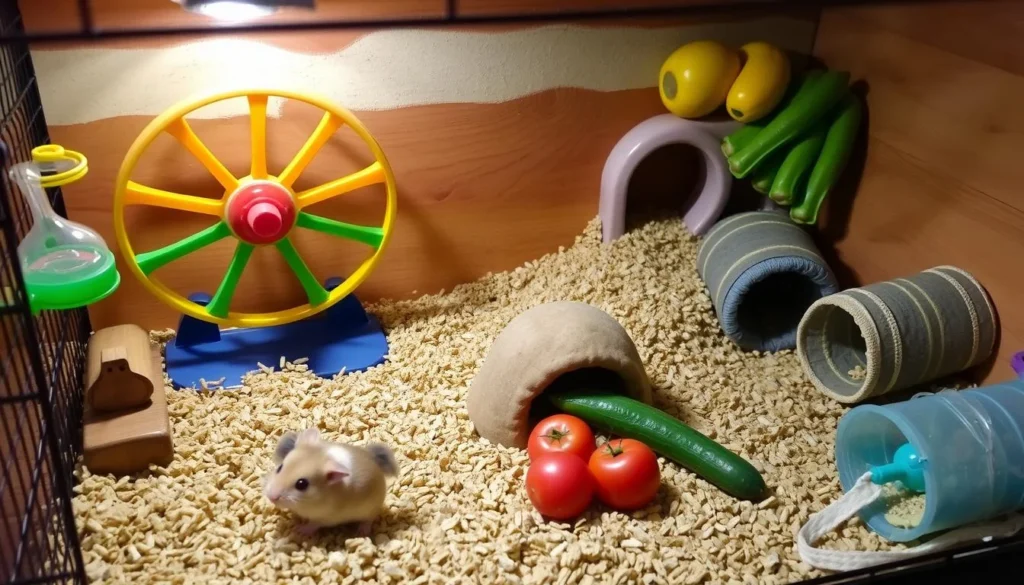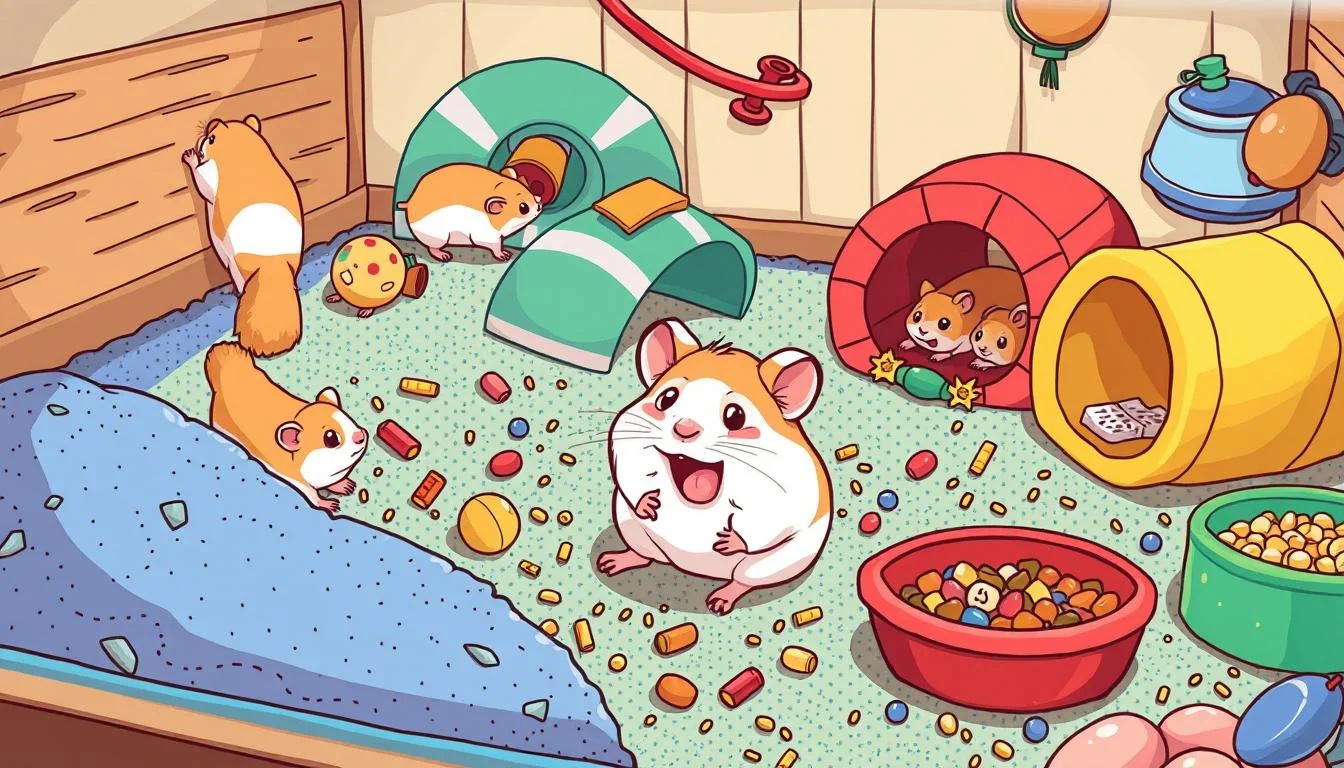Table of Contents
Ever watched a tiny hamster zip around its cage? Wondered what makes these cute creatures tick? My journey into hamster behavior started with a curious Syrian hamster named Whiskers. She showed me that these small pets are much more complex than people think.
Hamster behavior is a world of complex communication, survival instincts, and adaptability. To truly care for these tiny friends, you need to understand their natural behaviors and psychological needs. It’s not just about feeding and housing them.
Good hamster care is more than just keeping them clean. These night animals have special needs that can make your pet experience amazing. From their ability to run up to 5 miles in one night to their complex social talks, hamsters are tiny wonders waiting to be understood.
Key Takeaways
- Hamsters are complex creatures with unique behavioral patterns
- Proper understanding is key for the best hamster care
- Nocturnal animals need special attention and a right environment
- Each hamster species has its own traits and needs
- Watching their natural behaviors helps create better pet experiences
Getting to Know Different Hamster Species
Choosing a furry friend means knowing about hamster species. There are over 20 types, but only five are common pets in the U.S.

Hamster psychology is key in picking the right pet. Each species has its own traits that affect how they socialize and behave.
Syrian Hamsters vs Dwarf Varieties
Syrian hamsters are the top choice for pets. They are:
- 6-8 inches long
- 4-5 ounces heavy
- Domesticated for 90 years
- Known as the friendliest for beginners
Physical Characteristics and Traits
Hamster species vary greatly in size and looks:
- Roborovski Dwarf: Smallest, under 2 inches
- Chinese Hamsters: 4 inches long
- Winter White Russian Dwarfs: 3.5 inches long
- Campbell’s Dwarf: Up to 4 inches
Natural Habitat Origins
“The evolutionary history of hamsters extends back 11.2 to 16.4 million years in Europe and North Africa”
Knowing where hamsters come from helps understand their socialization. Their origins in different places shaped their behavior and survival skills.
Essential Care Requirements for Your Hamster

Creating the perfect home for your furry friend is key in hamster care. Your hamster needs a big and safe space that lets them act naturally and stay healthy. The best cage is at least 288 square inches, about 24 inches long, 12 inches wide, and 12 inches high.
When setting up your hamster’s home, remember these important points:
- Choose a cage with tight-fitting tops and secure closures
- Ensure bar spacing is 1/2 inch or less to prevent escapes
- Maintain a consistent temperature between 75°F to 85°F
- Place food and water stations away from sleeping areas
Hamster care means daily work and attention. Spot clean the cage daily and change the bedding weekly. Use a no-drip water bottle to keep the cage dry and avoid health problems.
“A well-designed habitat is the foundation of a happy, healthy hamster.”
Your hamster’s diet is also very important. Feed them once a day with a mix of high-quality seed and pellets. Add small amounts of fresh fruits and veggies, but make sure they’re not more than 10% of their diet.
- Avoid toxic foods like almonds and avocados
- Provide fresh water at all times
- Monitor portion sizes to prevent obesity
With the right care and enrichment, you’ll make a great home for your hamster. They’ll live a happy and healthy life.
Hamster Behavior: Natural Instincts and Patterns
Knowing how hamsters behave is key to caring for them well. These small animals have unique ways of thinking that make them different from other pets.
Hamster psychology offers interesting views into their lives. Their instincts are based on survival skills they’ve had for millions of years.
Nocturnal Activity Cycles
Hamsters are mostly active at night. Studies show they can be very active during this time:
- Most active during evening and early morning hours
- Can run up to 5 miles on their exercise wheel in a single night
- Require approximately 16 hours of sleep during daytime
“Hamsters release endorphins through their nighttime exercise, making running a critical part of their psychological well-being.”
Communication Methods
Hamsters have complex ways to communicate. Despite their small size, they show their feelings through different methods:
- Vocalizations like squeaks and chirps
- Body language signals
- Scent marking to establish territory
Territory and Space Requirements
Hamsters value their territory a lot. They need their own space to feel safe and happy. Giving them enough room helps prevent stress and keeps them healthy.
- Individual housing recommended
- Territorial nature means they prefer separate living spaces
- Enrichment items like climbers and mazes support mental stimulation
By understanding these natural instincts, you can create a harmonious environment that supports your hamster’s psychological and physical well-being.
Creating the Perfect Hamster Habitat
Creating a great home for your hamster is key for their health and joy. A well-thought-out habitat supports their natural behaviors and ensures they get the best care. Your hamster needs a big, enriching space that feels like their wild home.
When setting up a hamster habitat, consider these essential elements:
- Minimum floor space of 650 square inches for comfortable movement
- Deep bedding (8-10 inches) for natural burrowing
- Multiple hiding spots with varied textures
- Appropriate exercise wheel size based on hamster species
Hamster enrichment is more than just a home. Your pet needs mental challenges through:
- Multiple tunnels and exploration areas
- Sand baths for grooming
- Chew toys to maintain dental health
- Safe natural elements like untreated wood
“A happy hamster is an active hamster” – Veterinary Hamster Experts
Pro tip: Always freeze natural materials for 48 hours before introducing them to eliminate pests. Choose aspen wood shavings as the safest bedding option. This ensures your hamster’s comfort and safety.
Remember, each hamster is different. Watch what your pet likes and change their habitat to give them the best care.
Diet and Nutrition Guidelines
Proper nutrition is key for your hamster’s health and disease prevention. Knowing the right diet can greatly affect their behavior and well-being.
Hamster care means giving them a balanced diet. These small pets are omnivores, needing a variety of foods to stay healthy.
Recommended Food Types
- Commercial pellet diet (90% of daily intake)
- Fresh vegetables (alternated daily)
- Whole grains
- Small amounts of protein sources
Feeding Schedule and Portions
Hamsters have specific food behavior. Follow these portion guidelines:
- Offer 1/8-cup of seed mix daily
- Provide 2-3 tablespoons of pellets
- Limit total daily food intake to approximately 1/8-cup
Safe Treats and Supplements
When it comes to treats, moderation is important. Choose:
- Occasional nuts (1-2 small nuts per week)
- Small pieces of fresh fruits
- Whole-grain toast or cereals
“A balanced diet prevents nutritional deficiencies and supports your hamster’s health.” – Veterinary Nutrition Expert
Avoid toxic foods like citrus fruits, spicy peppers, and apple seeds. Careful diet management can prevent obesity and related health issues.
Exercise and Enrichment Activities
Keeping your hamster happy and healthy is key. These tiny athletes need lots of physical activity and mental challenges. Knowing their natural behaviors helps you create a fun and engaging environment.
Your hamster’s exercise routine should include several activities:
- Exercise wheel for nightly running
- Tunnel systems for exploration
- Climbing structures
- Foraging toys
“A stimulated hamster is a happy hamster!”
Exercise doesn’t just burn energy—it keeps boredom and stress away. Studies show daily activities and new toys can lower anxiety by up to 40%. Change your hamster’s toys every 2-4 weeks to keep them curious.
Think about creating a habitat with different levels and hiding spots. Experts say to provide at least 360-450 square inches of space. Use 3 inches of bedding to encourage burrowing.
- Use paper bedding
- Provide nesting materials
- Offer chew toys
- Create foraging opportunities
Every hamster is different. Watch what your pet likes and adjust their activities. Regular play and varied activities strengthen your bond with your small friend.
Common Health Issues and Prevention
Keeping your hamster healthy means watching them closely and acting fast. Knowing about health risks helps protect your pet. This way, your hamster can stay happy and healthy.
Recognizing Signs of Illness
Hamster care is all about watching your pet’s behavior and health. Look out for these important signs:
- Sudden changes in appetite or water consumption
- Unusual lethargy or decreased activity
- Skin problems like redness or hair loss
- Respiratory difficulties
- Unusual eye conditions
Performing Regular Health Checks
Regular health checks are key in hamster care. Experts suggest:
- Daily visual inspection of your hamster
- Weekly thorough health examination
- Checking teeth and fur condition
- Monitoring weight and activity levels
Emergency Care Essentials
Quick action can save your hamster’s life during health emergencies.
Here are some emergency care tips:
- Keep a veterinarian’s contact information handy
- Wash hands after handling to prevent disease transmission
- Isolate sick hamsters from other pets
- Maintain a clean, stress-free habitat
Remember, preventive care is always better than reactive treatment in hamster health management.
Building Trust and Handling Techniques
Building a strong bond with your hamster takes patience and understanding. Bonding with a hamster is a gentle process that needs consistent interaction. Your hamster needs time to feel safe and comfortable in their new home.
Here are some key strategies for starting hamster handling:
- Begin with soft speaking and food offerings for 7-10 days
- Limit initial interactions to short, calm sessions
- Always approach from the side, not from above
- Use slow, predictable movements
*”The key to successful hamster bonding is respect and patience.”*
Hamster handling techniques vary based on the pet’s personality. Some hamsters adjust fast, while others need weeks to feel comfortable. Daily 10-20 minute sessions outside their cage can help build trust and connection.
Here are some essential tips for safe hamster handling:
- Scoop them up gently from underneath
- Keep interactions close to the ground
- Avoid sudden movements or loud noises
- Use positive reinforcement with treats
Remember, each hamster is different. Some may learn tricks and become more interactive, while others prefer less handling. The most important thing is to create a safe, stress-free environment for your hamster to feel secure.
Conclusion
Understanding hamster behavior is key to a happy home for your small friend. Your journey with a hamster is more than just owning a pet. It’s about building a deep connection that sees their complex side.
Hamsters live 2 to 3 years, but those years can be filled with joy. This is true when you care for them with knowledge and compassion.
Every hamster is different, shaped by their species and traits. Knowing this can change how you see them. It’s not just about food and shelter. It’s about creating a space that respects their natural ways and meets their needs.
These tiny creatures are more than pets. They have unique personalities, ways of communicating, and needs. By learning about hamster behavior, you’ll make a home where they can flourish. Your effort to understand them will bring joy to both you and your hamster.
Successful hamster ownership mixes science and heart. Embrace your hamster’s unique traits, create a thoughtful space, and enjoy the bond you’ll form. These little companions are truly special.
